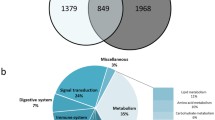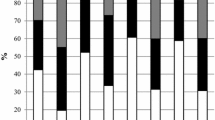Abstract
Alpha-linolenic acid (ALA) deficiency and a skewed n6:n3 fatty acid ratio in the diet is a major explanation for the prevalence of cardiovascular diseases and inflammatory/autoimmune diseases. There is mounting evidence of the health benefits associated with omega-3 long chain polyunsaturated fatty acids (LC PUFA’s). Although present in abundance in fish, a number of factors limit our consumption of fish based omega-3 PUFA’s. To name a few, overexploitation of wild fish stocks has reduced their sustainability due to increased demand of aquaculture for fish oil and meal; the pollution of marine food webs has raised concerns over the ingestion of toxic substances such as heavy metals and dioxins; vegetarians do not consider fish-based sources for supplemental nutrition. Thus alternative sources are being sought and one approach to the sustainable supply of LC-PUFAs is the metabolic engineering of transgenic plants with the capacity to synthesize n3 LC-PUFAs. The present investigation was carried out with the goal of developing transgenic safflower capable of producing pharmaceutically important alpha-linolenic acid (ALA, C18:3, n3). This crop was selected as the seeds accumulate ~ 78% of the total fatty acids as linoleic acid (LA, C18:2, n6), the immediate precursor of ALA. In the present work, ALA production was achieved successfully in safflower seeds by transforming safflower hypocotyls with Arabidopsis specific delta 15 desaturase (FAD3) driven by truncated seed specific promoter. Transgenic safflower fortified with ALA is not only potentially valuable nutritional superior novel oil but also has reduced ratio of LA to ALA which is required for good health.


Similar content being viewed by others
References
Baumlein H, Boerjan W, Nagy I, Panitz R, Inzé D, Wobus U (1991) Upstream sequences regulating legumin gene expression in heterologous transgenic plants. Mol Gen Genet 225:121–128
Belide S, Hac L, Singh SP, Green AG, Wood CC (2011) Agrobacterium-mediated transformation of safflower and the efficient recovery of transgenic plants via grafting. Plant Methods 7:12
Calder PC (2004) Fatty acids and cardiovascular disease: evidence explained and mechanisms explored. Clin Sci 107:1–11
Chamberland S, Daigle N, Bernier F (1992) The legumin boxes and the 3′ part of a soybean beta-conglycinin promoter are involved in seed gene expression in transgenic tobacco plants. Plant Mol Biol 19:937–949
Chandrasekharan MB, Bishop KJ, Hall TC (2003) Module-specific regulation of the beta-phaseolin promoter during embryogenesis. Plant J 33:853–866
Damude HG, Zhang H, Farrall L, Ripp KG, Tomb JF, Hollerbach D, Yadav NS (2006) Identification of bifunctional D12/ω-3 fatty acid desaturases for improving the ratio of ω-3 to ω-6 fatty acid in microbes and plants. Proc Natl Acad Sci USA 103:9446–9451
Domergue F, Abbadi A, Heinz E (2005) Relief for fish stocks: oceanic fatty acids in transgenic oilseeds. Trends Plant Sci 10:112–116
Doyle JJ, Doyle JL (1987) A rapid DNA isolation procedure for small quantities of fresh leaf tissue. Phytochem Bull 19:11–15
Eckert H, LaVallee B, Schweiger BJ, Kinney AJ, Cahoon EB, Clemente T (2006) Co-expression of the borage D6 desaturase and the Arabidopsis D15 desaturase results in high accumulation of stearidonic acid in the seeds of transgenic soybean. Planta 224:1050–1057
Finer JJ, Larkin KM (2008) Genetic transformation of soybean using particle bombardment and SAAT approaches. In: Kirti PB (ed) Handbook of new technologies for genetic improvement of legumes. CRC Press/Taylor and Francis Group, Boca Raton, pp 103–123
Fujiwara T, Beachy RN (1994) Tissue-specific and temporal regulation of a beta-conglycinin gene: roles of the RY repeat and other cis-acting elements. Plant Mol Biol 24:261–272
Ghawana S et al (2011) An RNA isolation system for plant tissues rich in secondary metabolites. BMC Res Notes 4:85–89
Hajdukiewicz P, Svab Z, Maliga P (1994) The small versatile pPZP family of Agrobacterium binary vectors for plant transformation. Plant Mol Biol 25:989–994
Hauser TP, Jørgensen RB, Østergård H (1998a) Fitness of backcross and F2 hybrids between weedy Brassica rapa and oilseed rape (B. napus). Heredity 81:436–443
Hauser TP, Shaw RG, Østergård H (1998b) Fitness of F1 hybrids between weedy Brassica rapa and oilseed rape (B. napus). Heredity 81:429–435
James DW, Dooner HK (1990) Isolation of EMS-induced mutants in Arabidopsis altered in seed fatty acid composition. Theor Appl Genet 80:241–245
Kankaanpaa P, Sutas Y, Salminen S, Lichtenstein A, Isolauri E (1999) Dietary fatty acids and allergy. Ann Med 31:282–287
Kostik V, Memeti S, Bauer B (2013) Fatty acid composition of edible oils and fats. JHED 4:112–116
Lelievre JM, Oliveira LO, Nielsen NC (1992) 5′CATGCAT-3′ Elements modulate the expression of glycinin genes. Plant Physiol 98:387–391
Lemieux B, Miquel M, Somerville C, Browse J (1990) Mutants of Arabidopsis with alterations in seed lipid fatty acid composition. Theor Appl Genet 80:234–240
Lexer C, Welch ME, Raymond O, Rieseberg LH (2003) The origin of ecological divergence in Helianthus paradoxus (Asteraceae): selection on transgressive characters in a novel hybrid habitat. Evolution 57:1989–2000
Li ZT, Gray D (2005) Isolation by improved thermal asymmetric interlaced PCR and characterization of a seed-specific 2S albumin gene and its promoter from grape (Vitis vinifera L.). Genome 48:312–320
Lindstrom JT, Vodkin LO, Harding RW, Goeken RM (1990) Expression of soybean lectin gene deletions in tobacco. Dev Genet 11:160–167
Liu HL, Yin ZJ, Xio L, Xu YN, Qu LQ (2012) Identification and evaluation of ω-3 fatty acid desaturase genes for hyperfortifying α-linolenic acid in transgenic rice seed. J Exp Bot 63:3279–3287
Mayerhofer M, Mayerhofer R, Topinka D, Christianson J, Good AG (2011) Introgression potential between safflower (Carthamus tinctorius) and wild relatives of the genus Carthamus. BMC Plant Biol 11:47
Mozaffarian D (2005) Does alpha-linolenic acid intake reduce the risk of coronary heart disease? Altern Ther Health Med 11:24–30
Nugent AP (2004) The metabolic syndrome. Nutr Bull 29:36–43
Poudyal H, Panchal SK, Diwan V, Brown L (2011) Omega-3 fatty acids and metabolic syndrome: effects and emerging mechanisms of action. Prog Lipid Res 50:372–387
Simopoulas AP (1991) Omega-3 fatty acids in health and disease and in growth and development. Am J Clin Nutr 54:438–463
Soxhlet F (1879) Die gewichtsanalytische Bestimmung des Milchfettes. Dingler’s Polytech J 232:461–465
Stark AH, Crawford MA, Reifen R (2008) Update on α-linolenic acid. Nutr Rev 66:326–332
Thomas TL (1993) Gene expression during plant embryogenesis and germination: an overview. Plant Cell 5:1401–1410
Trick HN, Finer JJ (1997) SAAT: sonication-assisted agro-bacterium-mediated transformation. Trans Res 6:329–337
Van der Geest AH, Hall TC (1996) A 68 bp element of the beta-phaseolin promoter functions as a seed-specific enhancer. Plant Mol Biol 32:579–588
Vrinten P, Hu Z, Munchinsky MA, Rowland G, Qiu X (2005) Two FAD3 desaturase genes control the level of linolenic acid in flax seed. Plant Physiol 139:79–87
Weselake RJ, Pomeroy MK, Furukawa TL, Golden JL, Little DB, Laroche A (1993) Developmental profile of diacylglycerol acyltransferase in maturing seeds of oilseed rape and safflower and microspore-derived cultures of oilseed rape. Plant Physiol 102:565–571
Williams CM, Burdge G (2006) Long-chain n-3 PUFA: plant v. marine sources. Proc Nutr Soc 65:42–50
Yadav NS, Wierzbicki A, Aegerter M, Caster CS, Perez-Grau L, Kinney AJ, Hitz WD, Booth JR, Schweiger B, Stecca KL, Allen SM, Blackwell M, Reiter RS, Carlson TJ, Russell SH, Feldmann KA, Pierce J, Browse J (1993) Cloning of higher plant ω-3 fatty acid desaturases. Plant Physiol 103:467–476
Yoshino M, Kanazawa A, Tsutsumi KI, Nakamura I, Shimamoto Y (2001) Structure and characterization of the gene encoding alpha subunit of soybean beta-conglycinin. Genes Genet Syst 76:99–105
Yoshino M, Nagamatsu A, Tsutsumi K, Kanazawa A (2006) The regulatory function of the upstream sequence of the beta-conglycinin alpha subunit gene in seed-specific transcription is associated with the presence of the RY sequence. Genes Genet Syst 81:135–141
Acknowledgements
Authors are thankful to Department of Biotechnology [DBT; Ref No. (BT/PR4077/AGR/2/832/2011)], India, for providing financial assistance. Arti Rani is thankful to the department of science and technology (DST) for providing fellowship under women scientist [WOS (A); Ref No. SR/WOS-A/LS-580/2013 dated 1.8.2014].
Author information
Authors and Affiliations
Corresponding author
Electronic supplementary material
Below is the link to the electronic supplementary material.
Fig. S1:
Figure showing cloning of βCG-FAD3 in plant expression vector pCAMBIA2300. (A) Confirmation of βCG clone in pBluescript vector: A release of 600 bp is observed after Sma I and Hind III double digestion; (B) Amplification of 1.3 Kb FAD3 from Arabidopsis thaliana cDNA; (C) Release of 1.9 Kb confirming βCG-FAD3 together in pCAMBIA2300 after BamH I and Sal I digestion. Fig. S2: a- A linear map of pCAMBIA2300-βCG-FAD3 gene cassette. The map is showing FAD3 gene (1308 bp) from Arabidopsis thaliana (NCBI GenBank accession number AY078043) under the control of seed specific promoter βCG, as cloned in lab. Plant selection marker NPT II is under control of CaMV 35S constitutive promoter and terminator. b-e-Development of transgenic safflower plants expressing FAD3: b-safflower hypocotyls used as explants for transformation; c-Putative transformed hypocotyls growing on selection medium containing 50 mg l−1 kanamycin; d-Putative transformed shoots emerging from transgenic calli; e-Putative transformed plantlets with roots; f- Hardened transgenic plants in pots; g-Transgenic plants in seed set stage growing in green house. Fig. S3: 1.2% agarose gel showing bands of 1.3 Kb obtained after amplification of FAD3 using gene specific primer pair and cDNA of putative transformed plants. (PPTX 786 kb)
Rights and permissions
About this article
Cite this article
Rani, A., Panwar, A., Sathe, M. et al. Biofortification of safflower: an oil seed crop engineered for ALA-targeting better sustainability and plant based omega-3 fatty acids. Transgenic Res 27, 253–263 (2018). https://doi.org/10.1007/s11248-018-0070-5
Received:
Accepted:
Published:
Issue Date:
DOI: https://doi.org/10.1007/s11248-018-0070-5




